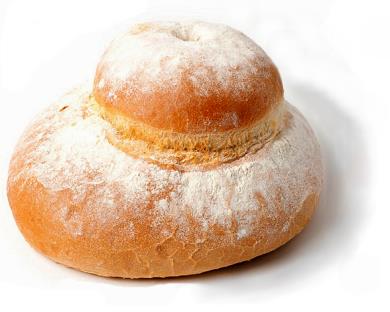

|
 Yeast-raised bread made from two spheres of dough placed one atop the other, the upper somewhat smaller than the lower, the two joined by forming an indent in the upper sphere down into the lower. Occasionally the upper bun is slashed around the edge to give a crown-like form when baked.  Cottage Loaf and Tin Bread contrasted Mrs.Beeton, 1863 The cottage loaf gives a much larger area of crust than other shapes, and so, according to Mrs.B is unsuitable for toast, "not being a good shape, and too crusty for the purpose." It is said to have been the commonest bread form until the second world war (Mason+Brown 2004). Cottage loaves are unusually tricky to make, and now rare. The name is known with certainty at least from the early 19th Century, the OED finds an early reference in the letters of the landscape painter and draughtsman, John Constable (1776–1837) " I send you a cottage loaf for Sunday." The origin of the form is unclear, but there is a similar pain chapeau (hat bread) in Brittany.  Cottage Loaf Image: www.specialitybreads.co.uk  |
|
MORE FROM Foods of England... Cookbooks ● Diary ● Index ● Magic Menu ● Random ● Really English? ● Timeline ● Donate ● English Service ● Food Map of England ● Lost Foods ● Accompaniments ● Biscuits ● Breads ● Cakes and Scones ● Cheeses ● Classic Meals ● Curry Dishes ● Dairy ● Drinks ● Egg Dishes ● Fish ● Fruit ● Fruits & Vegetables ● Game & Offal ● Meat & Meat Dishes ● Pastries and Pies ● Pot Meals ● Poultry ● Preserves & Jams ● Puddings & Sweets ● Sauces and Spicery ● Sausages ● Scones ● Soups ● Sweets and Toffee ● About ... ● Bookshop ● Email: editor@foodsofengland.co.uk COPYRIGHT and ALL RIGHTS RESERVED: © Glyn Hughes 2022 BUILT WITH WHIMBERRY |